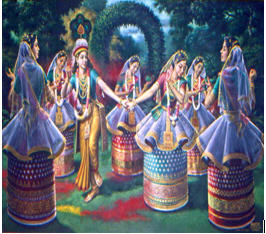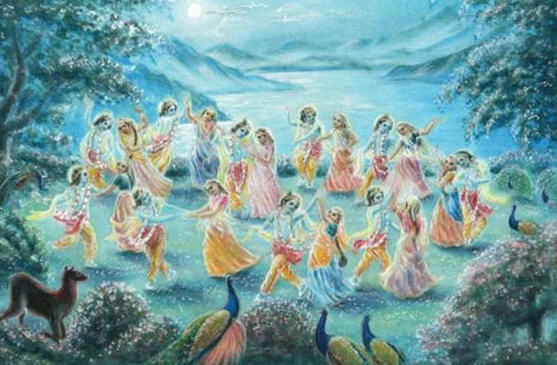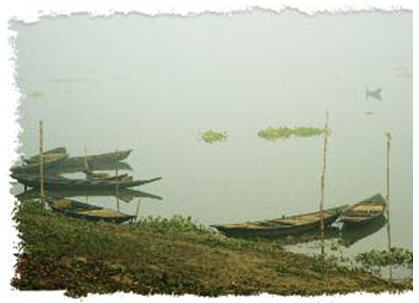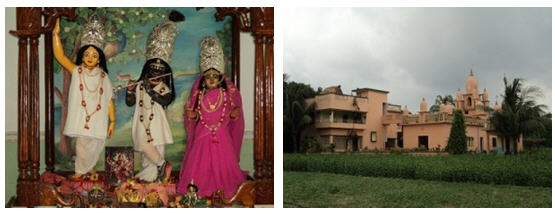
tatra pulinam asadya
pitham vrindavanatmakam
dadarsa kirtayan krishnam
sri-gauranga-mahaprabhuh
tatra rasa-sthalim drishtva
saparshada-rama-patih
sri-bhagavata-padyena
rasa-gitam cakara sah
smritva rasatmikam lilam
maha-bhava-dasam prabhuh
lebhe tatra maha-devi
puline rasa-mandape
divi dundubhayo neduh
babhuvuh pushpa-vrishtayah
jagadur munayo vedan
chandogyadi-svarupakan
sruti-mula-gate dirgha-
bahur mahaprabhuh
hare krishneti sankrosya
cacala jahnavi-tate
bhagirathim samuttirya
saparshadah saci-sutah
nama-sankirtane reme
rudra-dvipe samantatah
“Sriman Mahaprabhu Gaurasundara saw Vrindavana on the bank of the Ganga. Along with His associates, the Lord observed the Rasa-sthali there and started to chant the verses of Srimad-Bhagavatam relating to the rasa-lila. Oh, Mahadevi! By remembering rasa-lila at this place, Mahaprabhu entered into the state of maha-bhava. At that time dundubhi drums were sounded in heaven and flowers showered down. The sages were chanting the Chandogya and Vedamantras. When the devotees chanted the holy name directly into the ear of the Lord, the long-armed Mahaprabhu awoke from maha-bhava, loudly chanting ‘Hare Krishna! Hare Krishna!’ Then Sri Saci-nandana along with His associates went to the bank of the Bhagirathi Ganga, crossed it and wandered around Rudradvipa, immersed in namasankirtana.” (Navadvipa-dhamamahatmya, Pramana-khanda 4. 49-54)
Lord Nityananda proceeded south to Paradanga, Sri Pulina. On the way Lord Nityananda pointed out Sri Rasa-mandala and Dhira-samira. He said, “Oh, Jiva! Just see the eternal Vrindavana. One can always see the sweet Vrindavana pastimes here.” Hearing the word ‘Vrindavana’, Sri Jiva felt great ecstasy and tears of love poured from his eyes. Lord Nityananda said, “Sri Gauranga along with His devotees would chant the songs of rasa-lila here. Just as in Vrindavana there is the place of the maha-rasalila, in the same way at this place on the bank of the Jahnavi the Lord and the gopis perform the eternal rasa-lila. Lord Gauranga along with only His most fortunate devotees could have such intimate darsana. Towards the western side there is Sri Dhira-samira, this is the best place for performing bhajana. In Vraja this Dhira-samira is situated on the bank of the River Yamuna. Here Dhira-samira is situated on the bank of the Ganga. We see this river as Ganga but in reality it is not, because on the western side of the Ganga, the Yamuna is flowing. This beautiful forest is situated on the bank of the Yamuna, therefore Visvambhara calls this place Vrindavana. You should know that all the many pastime places of the Lord that exist in Vrindavana, simultaneously exist here. There is no difference between Vrindavana and Navadvipa. Similarly, do not think that there is any difference between Gauranga Mahaprabhu and Sri Krishnacandra.” Lord Nityananda was in great ecstasy due to maha-bhava. He showed Sri Jiva Vrindavana and proceeded some distance towards the north, spending the night in Rudradvipa.


